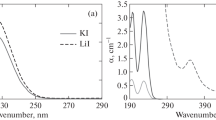Summary
A semi-micro procedure for the detection of chloride, bromide, iodide and thiocyanate is described. After metathesis of the silver salts with ammonium polysulphide and destruction of the excess sulphide, iodide is tested for with nitrite and starch, and if present, it is precipitated as lead iodide. Large amounts of thiocyanate are partly precipitated at this stage and the residual solution is tested with ferric alum for thiocyanate. This and traces of iodide are destroyed by boiling with nitrite. The solution is then treated with lead dioxide and the fluorescein test for bromide is applied. After boiling out the last traces of bromine, the solution is tested for chloride with silver nitrate.
Zusammenfassung
Ein Halbmikro-Verfahren zum Nachweis von Chlorid, Bromid, Jodid und Rhodanid wurde beschrieben. Nach Umsetzung der Silbersalze mit Ammoniumpolysulfid und Zerstörung des überschüssigen Sulfids wird mit Nitrit und Stärke auf Jodid geprüft, das dann gegebenenfalls als Bleijodid gefällt wird. Die Hauptmenge Rhodanid wird hierbei mitgefällt, das Filtrat wird mit Eisen(III)-alaun auf Rhodanid geprüft. Dieses und restliche Spuren Jodid werden durch Kochen mit Nitrit zerstört. Dann behandelt man die Lösung mit Bleidioxyd und prüft mit der Fluoreszeinprobe auf Bromid. Nach Verkochen der letzten Spuren Brom wird die Lösung mit Silbernitrat auf Chlorid untersucht.
Résumé
Description d'une semi-micro technique permettant de déceler les chlorures, les bromures, les iodures et les thiocyanates. Après double décomposition des sels d'argent en présence de polysulfure d'ammonium et après destruction de l'excès de sulfure, les iodures sont recherchés à l'aide de nitrite et d'emplois d'amidon; s'ils sont présents, ils sont précipités sous forme d'iodure de plomb. Lors de cette opération, une grande proportion de thiocyanates précipite et l'on recherche dans la solution résiduelle ces thiocyanates à l'aide d'alun ferrique. Une ébullition en présence de nitrite permet de d'etruire ces thiocyanates ainsi que d'éventuelles traces d'iodures. La solution est alors traités par le bioxyde de plomb et les bromures sont recherchés par l'essai à la fluorescéine. Après avoir chassé les derniéres traces de brome par ébullition, on recherche les chlorures dans la solution à l'aide de nitrate d'argent.
Similar content being viewed by others
References
A. A. Noyes andE. H. Swift, Qualitative Chemical Analysis of Inorganic Substances. New York: Macmillan. 1942. p. 339.
D. Hart andR. Meyrovitz, Ind. Eng. Chem., Analyt. Ed.13, 237 (1941).
H. Weisz, Mikrochim. Acta [Wien]1956, 1226.
F. Feigl, Spot Tests in Inorganic Analysis, 5th Edition. Amsterdam: Elsevier. 1958. p. 262.
Midlands Association for Qualitative Analysis, “Semi-micro Qualitative Inorganic Analysis, Advanced Tables”, 4th Edition. Birmingham. 1959. (Obtainable from Stanford and Mann Ltd., 72–73 New Street, Birmingham 2.)
Author information
Authors and Affiliations
Additional information
Part IX. Mikrochim. Acta [Wien]1959, 544.
Rights and permissions
About this article
Cite this article
Belcher, R., Stephen, W.I. Studies in qualitative inorganic analysis. X. Mikrochim Acta 47, 547–551 (1959). https://doi.org/10.1007/BF01221662
Received:
Published:
Issue Date:
DOI: https://doi.org/10.1007/BF01221662




